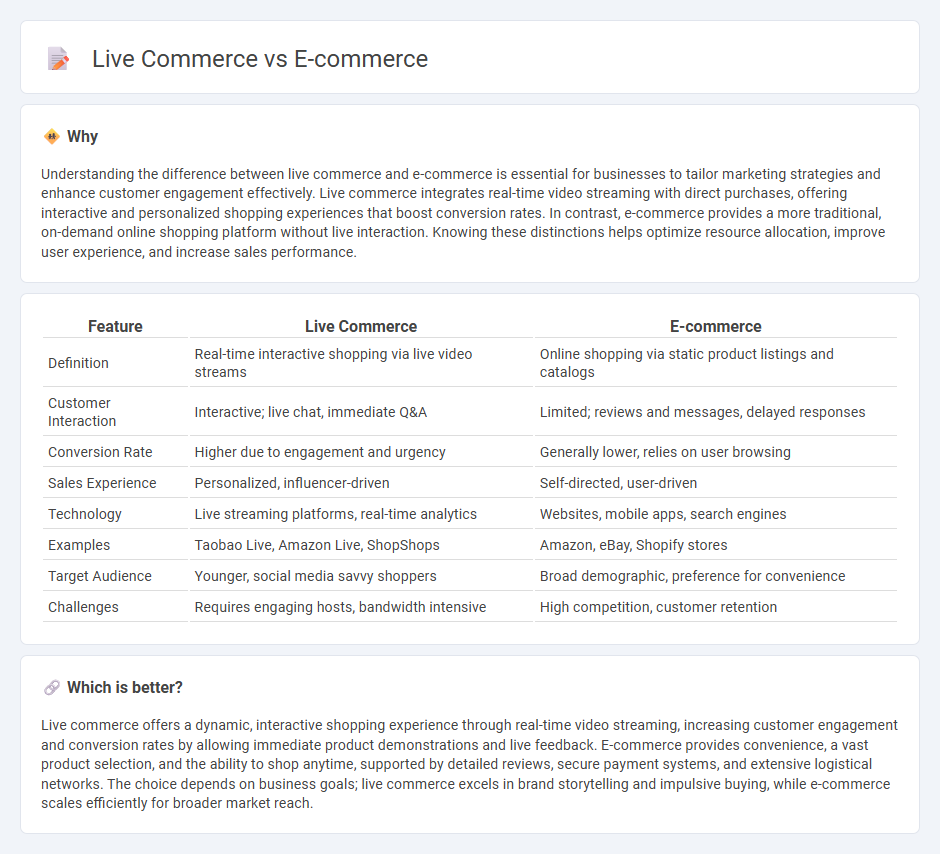
Live commerce merges real-time video streaming with online shopping, creating interactive and engaging purchasing experiences. E-commerce encompasses traditional online retail platforms where consumers browse and buy products asynchronously. Explore how these dynamic channels transform shopping behaviors and market strategies.
Why it is important
Understanding the difference between live commerce and e-commerce is essential for businesses to tailor marketing strategies and enhance customer engagement effectively. Live commerce integrates real-time video streaming with direct purchases, offering interactive and personalized shopping experiences that boost conversion rates. In contrast, e-commerce provides a more traditional, on-demand online shopping platform without live interaction. Knowing these distinctions helps optimize resource allocation, improve user experience, and increase sales performance.
Comparison Table
| Feature | Live Commerce | E-commerce |
|---|---|---|
| Definition | Real-time interactive shopping via live video streams | Online shopping via static product listings and catalogs |
| Customer Interaction | Interactive; live chat, immediate Q&A | Limited; reviews and messages, delayed responses |
| Conversion Rate | Higher due to engagement and urgency | Generally lower, relies on user browsing |
| Sales Experience | Personalized, influencer-driven | Self-directed, user-driven |
| Technology | Live streaming platforms, real-time analytics | Websites, mobile apps, search engines |
| Examples | Taobao Live, Amazon Live, ShopShops | Amazon, eBay, Shopify stores |
| Target Audience | Younger, social media savvy shoppers | Broad demographic, preference for convenience |
| Challenges | Requires engaging hosts, bandwidth intensive | High competition, customer retention |
Which is better?
Live commerce offers a dynamic, interactive shopping experience through real-time video streaming, increasing customer engagement and conversion rates by allowing immediate product demonstrations and live feedback. E-commerce provides convenience, a vast product selection, and the ability to shop anytime, supported by detailed reviews, secure payment systems, and extensive logistical networks. The choice depends on business goals; live commerce excels in brand storytelling and impulsive buying, while e-commerce scales efficiently for broader market reach.
Connection
Live commerce integrates real-time video streaming with e-commerce platforms, enabling interactive shopping experiences that boost customer engagement and conversion rates. E-commerce provides the digital infrastructure for online transactions, while live commerce leverages social interaction and instant product demonstrations to enhance buyer confidence. Together, they transform traditional online retail by combining seamless purchasing processes with immersive, personalized content delivery.
Key Terms
Online Marketplace
Online marketplaces have transformed the e-commerce landscape by providing a centralized platform where multiple sellers can offer products to a wide audience, facilitating seamless transactions and diverse product availability. Live commerce further enhances shopper engagement by integrating real-time video presentations and interactive features, enabling customers to experience products virtually and make instant purchases. Discover how these evolving online marketplace strategies can boost your sales and customer loyalty.
Real-time Interaction
Real-time interaction distinguishes live commerce from traditional e-commerce by enabling instant customer engagement through live video streaming and interactive chat features. This dynamic communication boosts conversion rates by fostering trust and creating a personalized shopping experience. Discover how integrating live commerce can transform your sales strategy and enhance customer satisfaction.
Conversion Rate
Live commerce outperforms traditional e-commerce in conversion rates, achieving up to 30% higher customer engagement and purchase frequency due to real-time interaction and personalized shopping experiences. Studies indicate that live streaming platforms can boost conversion rates from an average of 2-3% in e-commerce to 7-10% in live commerce channels. Explore in depth how integrating live commerce strategies can transform your sales funnel and maximize conversions.
Source and External Links
What Is Ecommerce? Guide To Selling Online (2025) - Shopify - Ecommerce is the buying and selling of goods and services over the internet, involving various transactional relationships such as B2C, B2B, and C2C, including online retail, wholesale, dropshipping, subscriptions, and digital products.
Glossary:E-commerce - Statistics Explained - Eurostat - E-commerce is defined as the sale or purchase of goods or services electronically via internet or online networks, including ordering and some online financial transactions, but excluding orders via manually typed emails.
E-commerce - Wikipedia - E-commerce refers to commercial activities involving electronic buying or selling online, supporting various transaction types such as online retailing, electronic markets, auctions, and encompassing business models like B2B, B2C, C2C, plus marketing and data gathering digitally.
 dowidth.com
dowidth.com